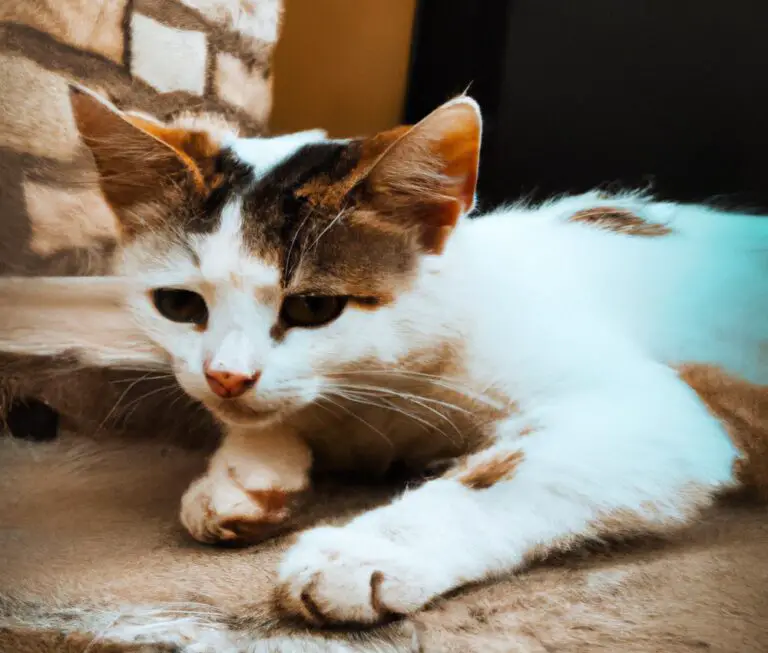The Pros And Cons Of Declawing Cats
Pros: Declawing cats may prevent them from damaging furniture or other items. It can also help protect their owners from scratches. Cons: Declawing cats can be painful and traumatic for them, and can lead to long-term health and behavioral issues. It is also an irreversible procedure.
When it comes to cats, one of the most controversial topics is declawing. As a former cat owner, I remember being faced with the difficult decision of whether to declaw my cat or not. My research around the topic revealed a variety of opinions and perspectives – some people believe declawing is humane and necessary, while others believe it is inhumane and should be avoided.
In this blog post, I will explore the pros and cons of declawing cats, as well as the long-term impacts and behavior problems associated with this procedure. Additionally, I will discuss alternative options to declawing and the common side effects to be aware of. Finally, I will provide guidance on what to do if you are considering declawing your cat.
What is cat declawing and why do people do it?
Have you ever wondered what cat declawing is, and why people do it? Cat declawing is a surgical procedure that removes the claws and the last bones of a cat’s paws. The procedure is controversial and has raised many debates, but it can be useful in certain situations.
In some cases, cat owners may choose this procedure as a first line of defense against destructive clawing. Cats can easily scratch and tear furniture and carpets, and declawing may help prevent this. Additionally, cat declawing may be desirable for households with small children or people with weakened immune systems as a way to reduce the risk of zoonotic diseases.
Still, declawing should never be taken lightly. It can be a painful and traumatic experience for the cat, and can sometimes lead to complications like infection and lameness. The procedure can also have long-term effects on the cat’s behavior, such as litter box avoidance and biting.
At the end of the day, it’s important to consider all the risks and benefits of cat declawing before making a decision. If you do decide to go ahead with it, make sure you choose a qualified veterinarian and follow their instructions to ensure the best possible outcome.
What are the pros of declawing a cat?
Declawing a cat is an issue that has been much debated in the pet-owning community. While it is a procedure that can have mixed results, there are some pros to consider when making the decision to declaw your cat.
If you live in a household with plenty of soft furniture, one of the biggest pros of declawing is the prevention of damage. Cats have sharp claws that can quickly tear up leather and fabric, and declawing can save you a lot of money in repair costs.
Another pro to consider is less stress for both you and your cat. Cats can bite and scratch when they become agitated or scared, and declawing can reduce the risk of injury to both you and your cat.
Finally, declawing can be beneficial for cats who are on long-term medications. Since cats often use their claws to remove their medication, declawing can help ensure that your cat is receiving the optimal dose of their medication.
Ultimately, declawing a cat has its pros and cons, and it’s important to do your research and weigh all of the options before making a decision. However, if you are looking for a way to protect your furniture and keep your cat and yourself safe, declawing may be worth considering.
What are the cons of declawing a cat?
Declawing a cat can have some serious drawbacks. If you’re considering declawing your cat, it’s important to understand the potential downsides to this procedure.
First and foremost, declawing a cat is a surgical procedure and therefore carries risks. As with any surgery, your pet may experience pain, bleeding, infection, and other complications. Additionally, the recovery time can be quite long, and your cat may be uncomfortable and irritable throughout that period.
Declawing can also lead to long-term behavior problems. Cats may become more aggressive or less active as a result of the procedure. Furthermore, declawed cats may become frustrated when they can’t use their claws to defend themselves or to hunt. As a result, cats may start using their teeth and jaws for these activities, which can lead to biting and other aggressive behaviors.
Finally, declawing can also impact the physical health of your cat. Removing a cat’s claws can lead to a variety of issues, such as joint pain, painful paw pads, and abnormal gait.
When considering whether to declaw your cat, it’s important to weigh the pros and cons carefully. If you do decide to declaw your cat, it’s essential that you work with a veterinary professional to ensure a safe and successful procedure.
Are there any alternatives to declawing?
Yes! There are alternatives to declawing cats that can help your feline friend keep their claws and still not destroy your furniture. The most common alternatives include nail trimming, soft paw covers, and scratching posts.
Nail trimming is a good option if your cat doesn’t mind having their claws trimmed on a regular basis. You can take them to a vet or groomer to have this done, or you can learn how to do it yourself. If you choose to do it yourself, make sure you have the right tools, like clippers, and that you are gentle with your cat.
Soft paw covers are another option. These act like little mittens that go over your cat’s claws to stop them from scratching. They can take some getting used to, but they’re a great way to help protect your furniture and keep your cat’s claws intact.
Scratching posts are a great way to encourage your cat to scratch a designated area instead of your furniture. Make sure you get a sturdy post, and you can even put some catnip on it to encourage your cat to use it. If your cat is determined to scratch the furniture, you can also use deterrent sprays or double-sided sticky tape to make it less appealing.
These are just a few of the alternatives to declawing cats. No matter which option you choose, be patient and don’t give up. With a little time and effort, you should be able to keep your cat’s claws and your furniture intact.
What are the common side effects of declawing?
Declawing cats is a controversial practice that comes with a few potential side effects. The most common side effects include soreness, infection, and chronic pain at the site of the surgery. Other potential side effects include behavioral issues such as biting and overgrooming, as well as an increased risk of arthritis due to the loss of natural padding on the bottom of their paws.
Soreness is the most common side effect of declawing. Immediately after the surgery, cats experience soreness in their paws, which can last for several weeks. This is due to the fact that the surgery involves cutting through bone, tendons, and other tissues in the paws, so it can be quite painful for cats.
Infection is another possible side effect of declawing. Because it is a surgical procedure, there is always the risk of infection at the site of the surgery. Cats should be closely monitored for signs of infection, such as redness, swelling, and discharge. If any of these signs are present, they should be taken to a veterinarian immediately.
Chronic pain is also a potential side effect of declawing. While the surgery is designed to be as minimally invasive as possible, there is still the potential for nerve damage. This could lead to chronic pain in the paw, which could be difficult to manage.
In addition to physical side effects, there is also the potential for behavioral issues such as biting and overgrooming. This is due to the fact that declawing can be quite traumatic for cats, and they may use biting and grooming as a way to cope with their stress.
Finally, there is the risk of arthritis due to the loss of natural padding on the bottom of their paws. This is because cats rely on the natural padding to provide cushioning while they walk and run, and the loss of this padding can put extra strain on their joints, which can lead to arthritis.
In conclusion, declawing cats comes with a few potential side effects. These include soreness, infection, chronic pain, behavioral issues, and an increased risk of arthritis. It is important to be aware of these potential side effects before making the decision to declaw a cat.
What are the long-term impacts of declawing?
Declawing cats can have long-term impacts both positive and negative. While some cats may benefit from declawing and it could reduce litter box issues and other behaviors caused by scratching, the long-term impacts are worth considering.
On the upside, declawing can stop cats from scratching furniture and other objects, which can save you money in the long run. It can also reduce the risk of infections and other potential illnesses associated with scratches. In some cases, declawing can help reduce aggression and stress in cats because they no longer feel the need to use their claws to defend themselves.
On the other hand, declawing can also have long-term negative impacts. It can be painful for cats, causing them physical discomfort for weeks or even months. It can also cause nerve damage, which can lead to chronic pain, and the use of anesthetic can lead to side effects. Additionally, long-term impacts of declawing can include behavioral changes and even a decrease in the cat’s quality of life.
Overall, it is important to consider both the potential positive and negative long-term impacts of declawing a cat before making the decision. Speak to your vet and do your research, so you can make an informed decision about what is best for your cat.
Does declawing lead to any behavior problems?
Yes, declawing your cat can lead to behavior problems. In fact, it’s been linked to behavioral issues such as aggression, litter box avoidance, biting, and general restlessness.
When a cat has been declawed, it can no longer use its claws as a defense mechanism and can feel vulnerable. This feeling of vulnerability can lead to aggression and restlessness as the cat is unable to protect itself.
Declawed cats also have trouble using their litter box as the litter can be uncomfortable on the raw paws. This can lead to litter box avoidance, which can cause anxiety and other issues. Declawed cats are more likely to bite as they can no longer rely on their claws as a defense mechanism.
On top of all this, declawing can be very painful, and the recovery process can take a long time. This can cause stress, discomfort, and can lead to other behavior problems.
In short, declawing can lead to a whole host of behavioral problems, so it’s important to carefully consider the pros and cons of declawing before making a decision.
What should you do if you are considering declawing your cat?
If you are considering declawing your cat, the first thing you should do is explore all of your other options. Declawing your cat should always be a last resort and should never be done on a whim. Talk to your vet about non-surgical alternatives, such as nail trimming or SoftPaws, which are plastic caps that are glued to a cat’s claws.
You should also consider the cat’s future. Declawing a cat can make it more difficult for them to climb or jump, which can be a real problem if you have multiple levels in your home. It’s also important to remember that declawing a cat can make them more aggressive, which can make it difficult to keep them and other pets in the same household safe.
Finally, make sure you know the potential risks associated with declawing. The procedure can cause pain and swelling, as well as an increased risk of developing an infection. In some cases, cats may also experience nerve damage and long-term problems with their paws.
Ultimately, if you are considering declawing your cat, it’s important to take the time to learn more about the procedure and all of your other options. Talk to your vet and do your own research to ensure that the decision you make is the best one for both you and your cat.

Frequently Asked Questions
What other potential health risks should i be aware of when considering declawing my cat?
When considering declawing your cat, you should be aware of other potential risks, such as the potential for infection, nerve damage, and behavioral changes. Your cat may also experience chronic pain and an inability to walk properly. Additionally, declawing may make your cat more prone to biting and scratching when they don’t have their claws. Overall, it’s important to research all the risks before deciding to declaw your cat.
Are there any specific breeds of cats that are more prone to needing declawing?
No, there is no specific breed of cat that is more prone to needing declawing than any other. However, some cats may be more likely to exhibit destructive behaviors like scratching furniture that could make declawing a more attractive option. Ultimately, the decision to declaw or not should be made with careful consideration, weighing the pros and cons as they relate to your particular cat and situation.
Are there any behavioral modifications i can do instead of declawing my cat?
Yes, there are many behavioral modifications you can do to avoid declawing your cat. These modifications include providing scratching posts, regular nail trimming, and rewarding good behavior. Additionally, it may be helpful to create an environment which is less likely to prompt unwanted behaviors, such as providing an appropriate number of litter boxes and toys for your cat.
Are there any other preventative measures i can take to reduce the need for my cat to be declawed?
Yes! To reduce the need for declawing, consider providing your cat with scratching posts, trimmings their nails regularly, and providing adequate playtime. Toys such as scratching mats, laser pointers, and interactive toys can also help keep them entertained. Additionally, it’s important to pay close attention to any behavior changes and address them accordingly.
What types of pain relief are typically used for cats that are going to be declawed?
Declawing cats is a controversial procedure, and it is important to consider the pros and cons before making a decision. The type of pain relief typically used for cats going through a declawing procedure includes a combination of anesthetic drugs, local nerve blocks and other pain medications. In some cases, sedatives or muscle relaxants may also be used.







